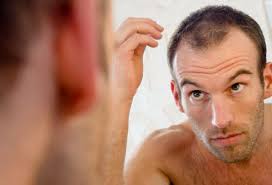Hair is a person’s crowning glory, and while this is very evident in females, it’s also true for males. Finding a male pattern baldness cure is a priority for many males, especially because baldness is quite unbecoming. Losing one’s hair is something no one would willingly wish upon himself, but baldness is actually quite common as a condition. It could start as the thinning of one’s hair, then you’ll notice that your hairline is receding particularly in the lateral area of the forehead. You may also notice that your crown is gradually thinning, and as time passes you eventually become bald. For males, 95% of cases is due to a male pattern baldness, a condition that is also known as androgenic alopecia.
Understanding androgenic alopecia
 Before looking at male pattern baldness treatment options, it’s important to first understand what the condition is and what we can do to prevent it. While pattern baldness varies, it’s clear that genetics plays some part in it. There is a “baldness gene” that can be passed around, and for many years before a male pattern baldness cure was discovered, people thought there was no way to solve it and they simply had to live with it. But now, male pattern baldness treatment options are available because they have pinpointed a way to inhibit what causes it in the first place.
Before looking at male pattern baldness treatment options, it’s important to first understand what the condition is and what we can do to prevent it. While pattern baldness varies, it’s clear that genetics plays some part in it. There is a “baldness gene” that can be passed around, and for many years before a male pattern baldness cure was discovered, people thought there was no way to solve it and they simply had to live with it. But now, male pattern baldness treatment options are available because they have pinpointed a way to inhibit what causes it in the first place.
Androgenic alopecia happens when testosterone is converted to DHT or dihydrotestosterone. The enzyme that does the converting is called 5α-reductase. DHT is a sex hormone that can affect not only the prostate but also the hair on the head, and this is why baldness occurs. To find a male pattern baldness cure means finding a way to inhibit 5α-reductase, and this is exactly what medication like Propecia does.
The power of Finasteride
Now that the cause of male pattern baldness has been identified, it’s now easier to find a solution for it. The generic medication Finasteride (marketed as Propecia and Proscar) is now being used to treat and prevent male pattern baldness, because it’s an effective type II 5α-reductase inhibitor. But the discovery of this medication hardly originated from baldness. It didn’t start off as a clinical trial that looked for a baldness cure, because at that time people really thought this was an impossible feat. Although it’s hard to believe, the discovery actually started with the prostate.
Finasteride was originally developed as a treatment for enlarged prostate glands. Prostate problems are also common among males, and this is what they were trying to solve when they discovered its effect on hair growth accidentally. This is because when they tested Finasteride on those with problems in the prostate, they noticed that one of the side effects was actually hair growth, and they couldn’t believe it. They then explored the idea of using it to treat male pattern baldness, which is also quite common. This is how Finasteride was developed as a medication used for male pattern baldness treatment. Its ability to induce hair growth on men is quite useful in making it a cure for baldness.
How to use Finasteride
When you take a drug like Propecia, this will contain 1mg of finasteride and this is enough to significantly lower the levels of DHT in the scalp. If you take Propecia daily, this reduces the DHT to as much as 60% and effectively stops the hair follicle from shrinking. Not only that, but it will also result to hair growth. In fact, it’s so effective that the American Hair Loss Association actually recommends it as the first treatment option for men who are suffering from male pattern baldness.
Other Options
While Finasteride is highly effective, there are of course other drugs that you can use to combat male pattern baldness. If you haven’t responded favorably to Finasteride or if you experience some of its side effects such as impotence as well as abnormal ejaculation and sex function, then perhaps you can try other medication options like Minoxidil (Rogaine). Just like Finasteride, this was originally developed as a medication for high blood pressure and one of the side effects discovered just happened to be hair growth – and on unexpected places too.
By applying Minoxidil topically, it helped hair growth in varying degrees. The American Hair Loss Association (AHLA) still recommends Finasteride as the first line of attack for men who suffer baldness, but Minoxidil is a good alternative. Whether you use Finasteride or Minoxidil, it’s clear that there are not options to help you cure male pattern baldness. Gone were the days of wondering whether or not hair would grow back, or simply living with the fact that it no longer will. Baldness is still in fact very common among males, but at least now we know it’s treatable and preventable.
Share This